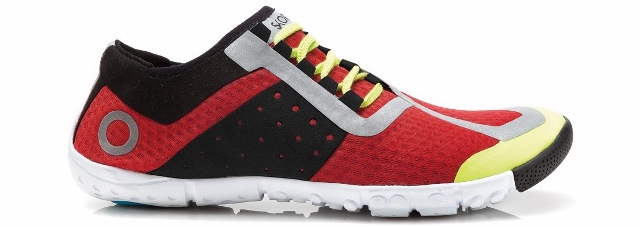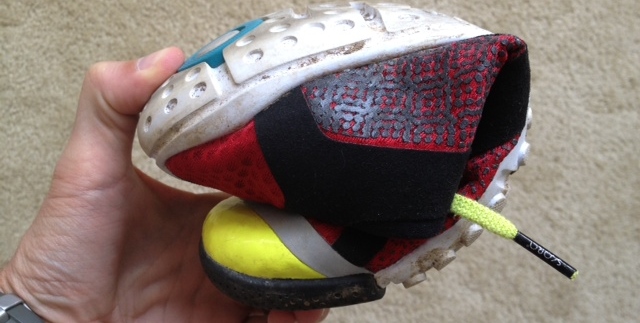Yesterday a friend admitted to me some quirky behaviors that are automatic disqualifiers for his dates.
Most are wildly inappropriate for SR, but his #1 was being a regular smoker.
It makes sense: he’s a fit guy and likes to lead a healthy lifestyle. There’s just no way he could date a smoker.
Many of us probably have similar disqualifiers – like having zero sense of humor. But how many of us have them for shoes?
Well, I realized that I do! There are certain disqualifiers when it comes to my running shoes that immediately stop me from buying – no questions asked.
Yes, even shoes must pass a rigorous test to see if they’re worthy for coming with me on a training run. All runners are this weird, right?
Now it’s important to understand that these are my disqualifiers. Just because I’ve found that these features don’t work for me doesn’t mean they won’t work for you. My experience and personal preferences are not applicable to every runner. Everyone is an individual.
So I want you to read this post with a critical eye. You may find that your stride pattern, foot strike, anatomy, and biomechanics are wildly different so you love these types of shoes.
That’s why it’s really helpful to experiment and try lots of different shoes to find what works best for your personal situation. That could be a variety of different styles – maybe you’ll love the Skora Phase that I review later in this article!
My three disqualifiers are common in bulkier, more motion-control shoes. Since I wear mostly neutral shoes, it’s easier to avoid them (you can see some of my favorite shoes on the Running Resources page).
Flared Heel? GTFO
A flared heel is one that extends behind the back of the shoe. Here’s a good visual:

The Minimus Road on the left has an inverted heel that mimics how your anatomical heel actually looks like. See how the back of the shoe goes mostly straight down and the heel actually curves underneath?
The Nike Free on the right has a flared heel that protrudes behind the shoe. It extends pretty far out.
This style can promote heel striking and makes it hard to have a neutral, flat-footed running stride. I’ve worn a similar model of the Free – and several other similar heels – and I find that my typical mild heel strike is exacerbated. It just makes me feel clunky.
While I don’t think heel striking is necessarily a bad thing, an aggressive heel strike isn’t something I want to encourage. So I simply don’t buy shoes with a significantly flared heel.
Arch Support? No Thank You
Whenever a pair of running shoes has a significant arch support, I get blisters. My low arches are compressed against the support inside the shoe and the inevitable running causes a lot of discomfort.
Higher arch supports are more common in more supportive shoes – duh! So expect to see them featured more prominently in “stability” or “motion-control” shoes. Since I typically train in neutral or more minimalist running shoes I don’t worry too much about buying an untested shoe that has a high arch.
Besides, I’d rather my own foot do most of the work rather than the shoe itself. The entire concept of arch support doesn’t make much sense to me since the arch is only as strong as its “keystone” (in architecture, the keystone is the final stone put at the apex of an arch that allows the structure to bear weight).
You never apply pressure underneath the keystone or you risk the entire structure falling apart.
Plus, the stretching, lengthening, and flattening of the human foot arch is a necessary movement during the gait cycle. If you disrupt that with support underneath the arch, you’ll get an increased risk of foot injuries. No thanks!
Beefy Sole? Not Interested!
This shoe characteristic is more subjective and really depends on how the shoe feels while running. I prefer shoes that have a medium sole height – not as high as the ASICS Gel-Blur which measures 35.1 mm, but not as low as a shoe like the Merrell T rail Glove.
My preference is to weigh my desire to feel more in touch with the ground with my need for stability. I pronate and roll pretty far inwardly on the inside part of my foot so I need some protection there. But shoes with a high sole make me feel disconnected from myself, the ground, and the run itself.
And for some reason, both low-profile and high-profile shoes aggravate my IT band and make me sore for days. If I don’t find that sweet spot of sole height then I’m as good as sidelined.
All of these shoe characteristics combined make for an injury waiting to happen for me. On the rare occasion I have to wear stiff dress shoes with a high arch and elevated heel, the next day my legs feel like they raced.
Instead, I stick to what I know works for me: casual shoes that are flexible, low to the ground, and with minimal support. My favorite shoes that I wear on a day to day basis:
- Sperry Top Sider (because boat shoes are baller)
- Rainbow Flip Flops
- Skora Form and Phase
- Chuck Taylors
The Skora Phase Review
Alright, now that you know more about my philosophy on shoes, how do the Skora Phase minimalist trainers fit in? For starters, they’re extremely minimal with a 0mm heel-toe drop and a weight of only 7.2 ounces. In fact, they have no midsole!

I wear the Phases mostly for hiking, lifting, and casually. Running in such a light shoe – with virtually no support – can aggravate my IT band. But I did test them while running and they deliver on their promise of providing a neutral ride with incredible ground feel.
In addition to the ground feel itself, I noticed that the rubber outsole has very good traction. Most of my running is in Rock Creek Park and they worked great on dirt, rocks, and gravel in addition to asphalt and concrete sidewalks.
The insole is 3mm thick and the outsole is 8mm thick. So you get 11mm of protection – and not much else. For me, this is perfect for walking and hiking to build the foot and lower leg muscles with a smaller injury risk than running.
I found that after long walks on concrete or asphalt my feet were more sore than after the same distance on trails. I walked about two miles from Cambridge into the city for the Boston Marathon and spent a few hours cheering runners on the course. The next day my feet were not happy!
Because there’s no midsole and there’s just a thin layer of rubber between you and the ground, you’ll experience more impact forces when walking and running. Keep that in mind when you wear them for long periods of time.

The unique aspect of the Skora Phase that I love is the asymmetrical lacing system that doesn’t irritate the tendons on the top of your foot. You can tie them as tight as possible with no constriction of the sensitive foot tendons – a big plus for those who prefer a snug fit. In the image above you’ll see that the laces move to the outside of the foot rather than going straight down the middle.
The lacing system also covers the “tongue” of the shoe, which is actually just a continuation of the upper. There’s really no tongue at all, which cuts down on the overall weight of the shoe and makes it quite flexible.
Just see how easy it is to bend them!

This flexibility makes the Phase an effective tool to strengthen your feet and lower legs. Combined with barefoot strides, you have a simple way to prevent more injuries by strengthening the often-neglected feet.
Of course, you may be hesitant to purchase these shoes because of the $110 price tag. They’re on the expensive side (though they cost substantially less than the Skora Form, likely because they’re synthetic instead of goat leather) but I think they’re worth it.
Because of the smart stitching and minimalist rubber outsole, they’ll last significantly longer than traditional running shoes. There’s no squishy foam to continually compress and wear out – it’s just rubber (which is similar to the old Nike Waffle flats except not as stiff).
I’d estimate you can get an extra 100-200 miles on them because of how well they’re manufactured – but I’ve heard of runners getting close to 1,000 total miles in them!
The Phase can be purchased on the Skora website or Amazon (slightly cheaper).